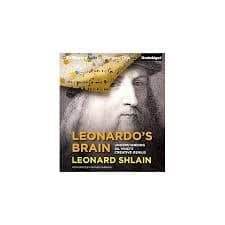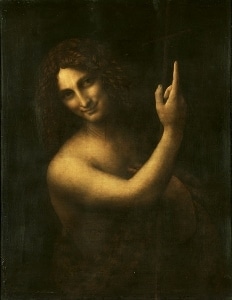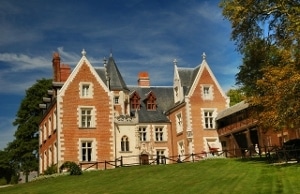Paranormal creativity?
Author: Leonard Shlain
 There’s no denying that he was a remarkable man. Given the incredible diversity he displayed over his five decades of discovery and innovation, a strong argument can be made that Leonardo da Vinci was both the greatest scientist and the greatest artist of all time. His myriad achievements so completely eclipsed the work of his contemporaries that historians have often struggled to explain how one man could do so much and do it all so well. Did the man have some sort of unique powers? Was he a time traveler? Or an extraterrestrial? Boldly drawing on a wide array of sources, surgeon and best-selling author Leonard Shlain has his own theories, which he reveals with passion and enthusiasm in Leonardo’s Brain, a work that had this skeptic frequently scratching his head.
There’s no denying that he was a remarkable man. Given the incredible diversity he displayed over his five decades of discovery and innovation, a strong argument can be made that Leonardo da Vinci was both the greatest scientist and the greatest artist of all time. His myriad achievements so completely eclipsed the work of his contemporaries that historians have often struggled to explain how one man could do so much and do it all so well. Did the man have some sort of unique powers? Was he a time traveler? Or an extraterrestrial? Boldly drawing on a wide array of sources, surgeon and best-selling author Leonard Shlain has his own theories, which he reveals with passion and enthusiasm in Leonardo’s Brain, a work that had this skeptic frequently scratching his head.
So, how do you perform an autopsy on a 500 year-old brain that long ago turned to dust? The answer according to Shlain – who died at the age of 71, shortly after completing this book – is to leave no stone unturned. Exhaustively combing through everything he could find about the great Italian, Shlain creates an incredible, in-depth portrait of Leonardo, revealing much about the man’s passions, disappointments, beliefs and struggles. The author creates a plausible psychological profile and even provides plenty of interesting speculation about how the man would view artistic and technological changes over the subsequent centuries.
Shlain also discusses the many paintings, discoveries, inventions and other creative works that made Leonardo so famous, employing plenty of shrewd artistic, scientific and political criticism to place the man in an appropriate 15th and early 16th century context. While he often resorts to hyperbole – although there may have never been a man more deserving of it – Shlain’s summary of Leonardo’s life makes for great reading in the first two thirds of the book. It’s the last third that left me disappointed.
Like any historical figure, Leonardo exhibited a collection of personality traits and skills, some of them quite extraordinary. Relying on the profile he creates, Shlain successfully argues that the man may have been able to tap into his right brain more successfully than anyone before or since. But he goes much further than that. Employing the latest in 21st century neuroscience, human sexuality and quantum physics, Shlain proposes a host of bold and bizarre theories about Leonardo’s neurologic skill set. Theories that this reader found overly enthusiastic and fanciful for a book ostensibly based on science. Shlain even predicts the future of human evolution, based on the life story of a man who never had any children.
At its best, Leonardo’s Brain is a fascinating and passionately told psychological biography of the greatest scientist who ever lived. At its worst, it’s a collection of flimsy – bordering on crackpot – theories based on a facile cherry picking of details from Leonardo’s life, as well as an intentionally biased manipulation of neuroanatomical statistics. Carefully look at my brain. Can you tell what kind of person I am? Right handed or left handed? Woman or man? Gay or straight? Liberal or conservative? I’m no expert, but I find it hard to believe that neuroanatomy is destiny and Shlain has failed to convince me otherwise. His reliance in the second half of the book on a series of just-so-stories about creativity, cerebral hemispheres and human evolution – seasoned with a pungent blast of paranormal conjecture – left me disappointed. X-Files fans might like the book. True skeptics will be unimpressed.
— D. Driftless
chateau image by Nadegevillain
- Best Non-Fiction of 2016 - February 1, 2017
- Little Free Library Series — Savannah - May 22, 2015
- Little Free Library Series — Wyoming - November 30, 2014





Leave A Comment